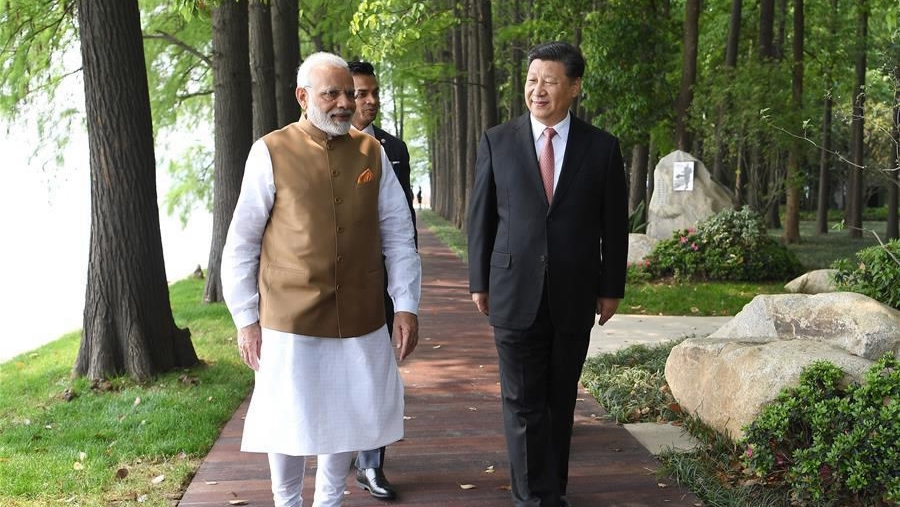Editor's note: Keith Lamb is a University of Oxford graduate with a MSc degree in Contemporary Chinese Studies. His primary research interests are the international relations of China and China's "Socialism with Chinese Characteristics." The article reflects the author's opinions, and not necessarily the views of CGTN.
India has reported 20 casualties in a border dispute that broke out in the strategic Galwan Valley in the Ladakh region on Monday. China traditionally does not release its casualty count outside of peacekeeping missions. India claims that China was erecting a structure on the Indian side of control while China claims that Indian troops repeatedly entered the Chinese line of control.
This outbreak of violence cannot be taken lightly but tellingly both sides have remained restrained. Indian Prime Minister Narendra Modi's public message reiterated India's policy of peaceful coexistence. Likewise, remarks by Zhao Lijian from China's Foreign Ministry were unobtrusive as he stressed that both China and India have agreed to resolve problems through dialogue and make efforts to ease the situation.
This is an astute response by both nations who have too much in common to allow their border dispute to define their long-term relationship. As large developing civilizational states with ancient histories, their circumstances are similar. Both share the common goal and arduous task of delivering prosperity to their citizens.
Mutual access to each other's markets provides a springboard for development. According to India's Department of Commerce, the Chinese mainland combined with Hong Kong makes up India's second-largest export market. India is China's seventh-largest destination for exports but this will inevitably increase in the future.
Both Modi and Xi, who share a personal rapport, are keen to engage in a Regional Comprehensive Economic Partnership. This will lead to increased Chinese capital funding for Indian projects. There will be more scientific cooperation, and crucially China will import more Indian goods which will decrease India's trade deficit with China.

Chinese President Xi Jinping (R) walks with Indian Prime Minister Narendra Modi in Wuhan, capital of central China's Hubei Province, April 28, 2018. /Xinhua
Chinese President Xi Jinping (R) walks with Indian Prime Minister Narendra Modi in Wuhan, capital of central China's Hubei Province, April 28, 2018. /Xinhua
In the geopolitical realm, both sides are wary of each other's intentions which further raise pressure and feed into the border dispute. However, in the long geopolitical outlook, India and China's interests are closely tied.
India feels threatened by China's Belt and Road initiative which encompasses land infrastructure across Pakistan and port facilities in Sri Lanka. Likewise, China which is already surrounded by U.S. military bases, fears India is being pulled into America's Indo-Pacific strategy to contain China. This fear is further highlighted by India's media echoing the U.S. news feed about COVID-19 which China believes is scientifically unfounded.
Nevertheless, both countries are members of the non-aligned movement which marks them out as actors who are against hegemony. Neither China nor India seeks untoward interference in each other's political-economic system. Both are members of BRICS and the Shanghai Cooperation Organization. Both India and China have a shared dream for a multi-polar world order which will give both their respective civilizations space to flourish.
In addition, contextualizing the China-India border dispute also goes some way in relieving tensions. Both sides must keep in mind that historically India and China's borders stem from the hangover of the British colonial legacy. Neither side can be blamed for this even if they are both left to clean up the mess. Also, because both sides do not recognize each other's territorial claims they do not face each other over a well-defined border. Instead, they operate along two sides of the Line of Actual Control (LAC) which is poorly demarcated, and consequently, accidents are sometimes inevitable.
The border dispute is such a thorny issue and there is mutual distrust on both sides. Consequently, I am not suggesting that fixing this problem will be a walk in the park. Today, China and India are far from Nehru's dictum "Hindi-Chini bhai-bhai" (Indians and Chinese are brothers), but there is simply too much at stake and so much shared opportunity for cooperation that conflict between these two nuclear-armed giants would be reckless.
While many people have already declared the early 21st century as one defined by China's rise the second half will surely, if current trends continue, be one defined by both China and India. As such dialogue is the only sensible option. Through amicable dispute resolution, both powers can provide a model for future great power relations that have thus far eluded previous world orders.
Except for the border issue, India and China do not have any long-standing obstacles. Indeed, their major historical connection has been their shared history of Buddhism which started in India but spread peacefully along the Silk Road where it flourished in China. Today this Buddhist heritage and fondness of India is still celebrated in the Chinese literary classic "Journey to the West."
While today's relations are strained and events that have transpired are tragic, I am nevertheless, amazed that this conflict is described as a "brawl" taking place without resorting to the use of arms. Indeed, the last shooting took place in 1975. This non-carrying of guns could only have been achieved through sincere cooperation between India and China. Considering they face off on what is one of the most disputed border areas in the world, this is a tremendous achievement.
The first task now is to make sure this unarmed status-quo remains. The second task is to continue with the strengthening of Chinese-Indian ties on all levels so that this historical border hangover doesn't overshadow long-term future comprehensive collaboration.
(If you want to contribute and have specific expertise, please contact us at opinions@cgtn.com.)